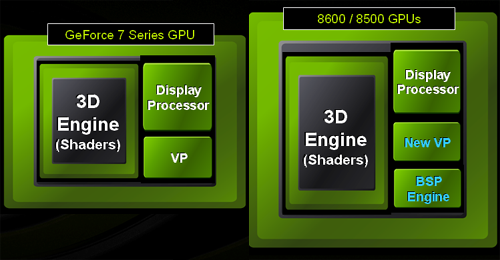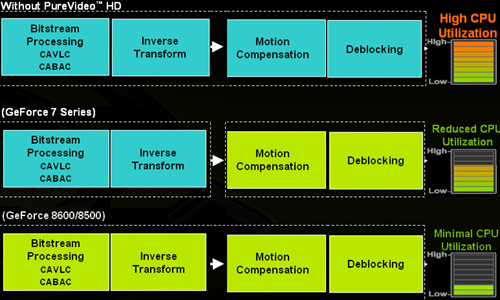DX10 for the Masses: NVIDIA 8600 and 8500 Series Launch
by Derek Wilson on April 17, 2007 9:00 AM EST- Posted in
- GPUs
The New Face of PureVideo HD
The processing requirements of the highest quality HD-DVD and Blu-ray content are non-trivial. Current midrange CPUs struggle to keep up without assistance and older hardware simply cannot perform the task adequately. AMD and NVIDIA have been stepping in with GPU assisted video decode acceleration. With G84, NVIDIA takes this to another level moving well beyond simply accelerating bits and pieces of the process.
The new PureVideo hardware, VP2, is capable of offloading the entire decode process for HD-DVD and Blu-ray movies. With NVIDIA saying that 100% of the H.264 video decode process can be offloaded at up to 40 Mbits/sec on mainstream hardware, the average user will now be able to enjoy HD content on their PC (when prices on HD-DVD and Blu-ray drives fall, of course). There will still be some CPU involvement in the process, as the player will still need to run, AACS does have some overhead, and the CPU is responsible for I/O management.
This is quite a large change, even from the previous version of PureVideo. One of the most processing intensive tasks is decoding the entropy encoded bitstream. Entropy encoding is a method of coding that creates variable length symbols where the size of the symbol is inversely proportional to the probability of encountering it. In other words, patterns that occur often will be represented by short symbols when encoded while less probable patterns will get larger symbols. NVIDIA's BSP (bitstream processor) handles this.

Just adding the decoding of CABAC and CAVLC bitstreams (the two types of entropy encoding supported by H.264) would have helped quite a bit, but G84 also accelerates the inverse transform step. After the bitstream is processed, the data must go through an inverse transform to recover the video stream which then must have motion compensation and deblocking performed on it. This is a bit of an over simplification, but 100% of the process is 100% no matter how we slice it. Here's a look at the breakdown and how CPU involvement has changed between VP1 and VP2.

We have a copy of WinDVD that supports the new hardware acceleration and we are planning a follow up article to investigate real world impact of this change. As we mentioned, in spite of the fact that all video decoding is accelerated on the GPU, other tasks like I/O must be handled by the CPU. We are also interested in finding videos of more than 40 Mbit/sec to try and push the capabilities of the hardware and see what happens. We are interested in discovering the cheapest, slowest processor that can effectively play back full bandwidth HD content when paired with G84 hardware.
It is important to emphasize the fact that HDCP is supported over dual-link DVI, allowing 8600 and 8500 hardware to play HDCP protected content at its full resolution on any monitor capable of displaying 1920x1080. Pairing one of these cards with a Dell 30" monitor might not make sense for gamers, but for those who need maximal 2D desktop space and video playback, the 8600 GT or GTS would be a terrific option.
While it would be nice to have this hardware in NVIDIA's higher end offerings, this technology arguably makes more sense in mainstream parts. High end, expensive graphics cards are usually paired with high end expensive CPUs and lots of RAM. The decode assistance that these higher end cards offer is more than enough to enable a high end CPU to handle the hardest hitting HD videos. With mainstream graphics hardware providing a huge amount of decode assistance, the lower end CPUs that people pair with this hardware will benefit greatly.
The processing requirements of the highest quality HD-DVD and Blu-ray content are non-trivial. Current midrange CPUs struggle to keep up without assistance and older hardware simply cannot perform the task adequately. AMD and NVIDIA have been stepping in with GPU assisted video decode acceleration. With G84, NVIDIA takes this to another level moving well beyond simply accelerating bits and pieces of the process.
The new PureVideo hardware, VP2, is capable of offloading the entire decode process for HD-DVD and Blu-ray movies. With NVIDIA saying that 100% of the H.264 video decode process can be offloaded at up to 40 Mbits/sec on mainstream hardware, the average user will now be able to enjoy HD content on their PC (when prices on HD-DVD and Blu-ray drives fall, of course). There will still be some CPU involvement in the process, as the player will still need to run, AACS does have some overhead, and the CPU is responsible for I/O management.
This is quite a large change, even from the previous version of PureVideo. One of the most processing intensive tasks is decoding the entropy encoded bitstream. Entropy encoding is a method of coding that creates variable length symbols where the size of the symbol is inversely proportional to the probability of encountering it. In other words, patterns that occur often will be represented by short symbols when encoded while less probable patterns will get larger symbols. NVIDIA's BSP (bitstream processor) handles this.

Just adding the decoding of CABAC and CAVLC bitstreams (the two types of entropy encoding supported by H.264) would have helped quite a bit, but G84 also accelerates the inverse transform step. After the bitstream is processed, the data must go through an inverse transform to recover the video stream which then must have motion compensation and deblocking performed on it. This is a bit of an over simplification, but 100% of the process is 100% no matter how we slice it. Here's a look at the breakdown and how CPU involvement has changed between VP1 and VP2.

We have a copy of WinDVD that supports the new hardware acceleration and we are planning a follow up article to investigate real world impact of this change. As we mentioned, in spite of the fact that all video decoding is accelerated on the GPU, other tasks like I/O must be handled by the CPU. We are also interested in finding videos of more than 40 Mbit/sec to try and push the capabilities of the hardware and see what happens. We are interested in discovering the cheapest, slowest processor that can effectively play back full bandwidth HD content when paired with G84 hardware.
It is important to emphasize the fact that HDCP is supported over dual-link DVI, allowing 8600 and 8500 hardware to play HDCP protected content at its full resolution on any monitor capable of displaying 1920x1080. Pairing one of these cards with a Dell 30" monitor might not make sense for gamers, but for those who need maximal 2D desktop space and video playback, the 8600 GT or GTS would be a terrific option.
While it would be nice to have this hardware in NVIDIA's higher end offerings, this technology arguably makes more sense in mainstream parts. High end, expensive graphics cards are usually paired with high end expensive CPUs and lots of RAM. The decode assistance that these higher end cards offer is more than enough to enable a high end CPU to handle the hardest hitting HD videos. With mainstream graphics hardware providing a huge amount of decode assistance, the lower end CPUs that people pair with this hardware will benefit greatly.










60 Comments
View All Comments
JarredWalton - Tuesday, April 17, 2007 - link
It's not surprising that G84 has some enhancements relative to G80. I mean, G80 was done six months ago. I'd expect VP2 is one of the areas they worked on improving a lot after comments post-8800 launch. Now, should they kill the current G80 and make a new G80 v1.1 with VP2? That's up for debate, but you can't whine that older hardware doesn't have newer features. "Why doesn't my Core 2 Duo support SSE4?" It's almost the same thing. I wouldn't be at all surprised to see a new high-end card from NVIDIA in the future with VP2, but when that will be... dunno.harshw - Tuesday, April 17, 2007 - link
So ... to confirm, the card *does* let you watch HDCP content on a Dell 3007WFP at 2560x1600 ? Of course, the card would probably scale the stream to the panel resolution ...
DerekWilson - Tuesday, April 17, 2007 - link
The card will let you watch HDCP protected content at the content's native resolution -- 1920x1080 progressive at max ...Currently if you want to watch HDCP protected content on a Dell 30", you need to drop your screen resolution to 1280x800 and watch at that res -- the video is downscaled from 1920x1080. Higher resolutions on the panel require dual-link DVI, and now HDCP protected content over a dual-link connection is here.
AnnonymousCoward - Tuesday, April 17, 2007 - link
Maybe I'm in the minority, but I don't care about this HDCP business. The players are still ultra expensive, and the resolution benefit doesn't really change how much I enjoy a movie. Also, a 30" screen is pretty small to be able to notice a difference between HD and DVD, if you're sitting at any typical movie-watching distance from the screen. Well, I would guess so at least.Spoelie - Wednesday, April 18, 2007 - link
We're talking about 30" lcd monitors with humongous resolutions, not old 30" lcd tvs with 1386x768 something.Or do your really don't see any difference between
http://www.imagehosting.com/out.php/i433150_BasicR...">http://www.imagehosting.com/out.php/i433150_BasicR... and http://www.imagehosting.com/out.php/i433192_HDDVD....">http://www.imagehosting.com/out.php/i433192_HDDVD....
or
http://www.imagehosting.com/out.php/i433157_BasicR...">http://www.imagehosting.com/out.php/i433157_BasicR... and http://www.imagehosting.com/out.php/i433198_HDDVD....">http://www.imagehosting.com/out.php/i433198_HDDVD....
Myrandex - Tuesday, April 17, 2007 - link
I loved it how the two 8600 cards listed 256MB memoy only however the 8500 card showed 256MB / 512MB. Gotta love marketing in attempting to grab the masses attention by throwing more ram into a situation where it doesn't really help...Jason
KhoiFather - Tuesday, April 17, 2007 - link
Horrible, horrible performance. I'm so disappointed its not even funny! I'm so waiting for ATI to release their mid-range cards and blow Nvidia out the water to space.jay401 - Tuesday, April 17, 2007 - link
Very true, and not only because the vast majority of gamers are still running XP, but also because no games out to this point gain anything from DX10/Vista (aside from one or two that add a few graphical tweaks here and there in DX10).
When there are enough popular, well-reviewed DX10/Vista focused games available that demonstrate appreciable performance improvement when running in that environment, such that you can create a test suite around those games, then it would be time to transition to that sort of test setup for GPUs.
Griswold - Tuesday, April 17, 2007 - link
The real reason would that nobody wants to go through the nightmare of dealing with nvidia drivers under vista. ;)jay401 - Tuesday, April 17, 2007 - link
Derek you should add the specs of the 8800GTS 320MB to the spec chart on page 2, unless of course NVidia forbids you to do that because it would make it too obvious how they've cut too many stream processors and too much bus size from these new cards.Now what they'll do is end the production of the 7950GTs to ensure folks can't continue to pick them up cheaper and will be forced to move to the 8600GTS that doesn't yet offer superior performance.
gg neutering these cards so much that they lose to your own previous generation hardware, NVidia.